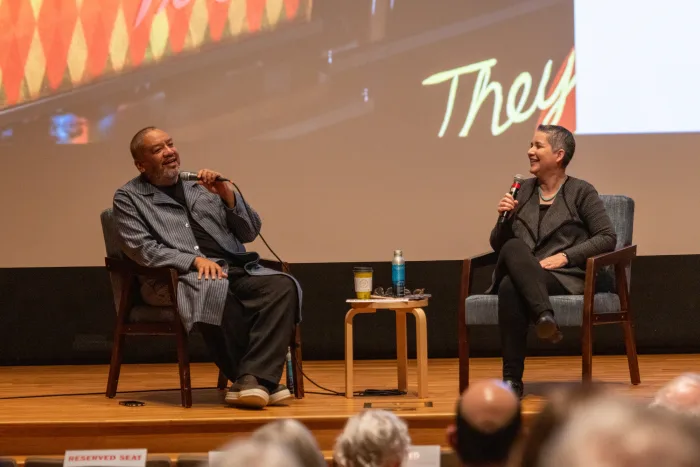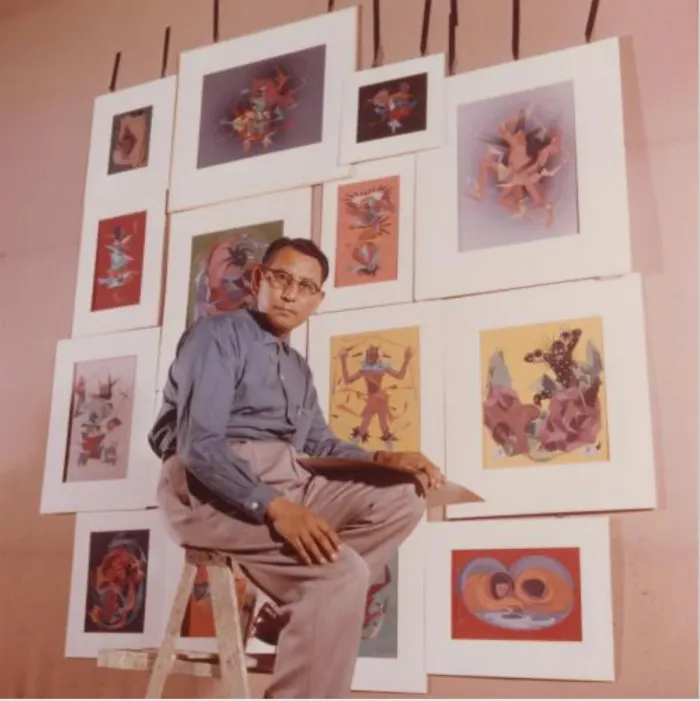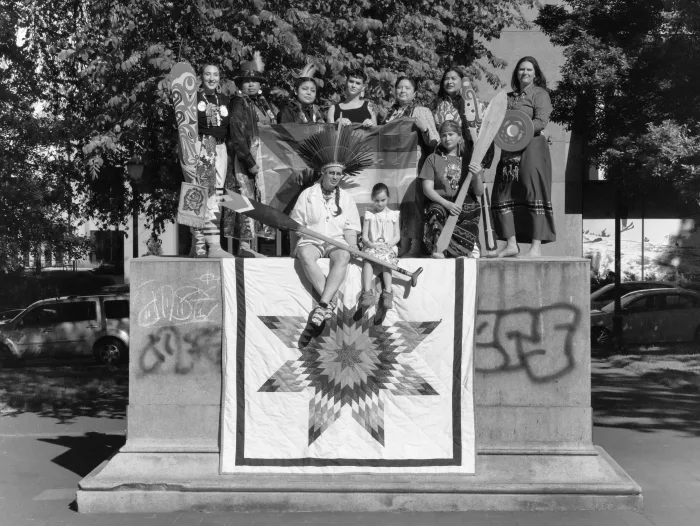The future past: Native artists in conversation
Jarrette Werk
Underscore News / Report For America via ICT

Last May, 138 Portland community members, majority Indigenous, responded to the Portland Art Museum’s open call to participate in Gibson’s exhibit, “They Come From Fire.” Gibson said he asked participants to show up “the way they wished to be seen.” (Photo By Jarrette Werk, Underscore News and Report for America)
Dakota modernist Oscar Howe redefined Native art, making space for younger artists. New exhibits showcase the conversation between Howe and contemporary Native artist Jeffrey Gibson
When artist Jeffrey Gibson reflected on the 2020 social uprising embodied by the Black Lives Matter movement and activism for Indigenous rights in Portland, Gibson knew he could create something special.
Gibson, a citizen of the Mississippi Band of Choctaw who also has Cherokee ancestry, and Kathleen Ash-Milby, curator of Native American art at Portland Art Museum, saw an opportunity to use the vacant pedestals that once held statues of problematic and glorified presidents like Abraham Lincoln and Theodore Roosevelt. They wanted to reclaim those spaces with visual rhetoric and performance.
Gibson and Ash-Milby, a citizen of the Navajo Nation, were surprised when 138 people showed up to a call for portrait subjects. With so many willing participants, Gibson and photographer Brian Barlow, spent three full days photographing children, distinguished elders, LGBTQ+ artists and activists.
“I didn’t tell anyone to bring anything, the only thing I asked of them was to present themselves the way they wished to be seen,” said Gibson.
The outcome – a series of portraits that radiate with transformative energy – reveals the sense of kinship that exists in Indigenous communities.
“Everything made sense and everything came together,” Ash-Milby said.
The central courtyard at the Portland Art Museum is covered with black and white portraits of the 138 Indigenous, BIPOC and LGBTQ community participants in Gibson’s photo exhibit, “They Come From Fire.” Twelve luminescent, text-filled glass panels cast kaleidoscopic shadows onto the walls, seeming to bring the photos to life.
“When we took the photographs and looked at them all together, we were like, “This could exist anywhere,’” Gibson said. “These images could speak to so many other places, not just Portland.”

On the other side of the building, vibrant geometric graphics in red, yellow and blue cover the sixty-nine exterior windows of the Portland Art Museum, leading visitors through the often overlooked timeline of the Indigenous history in Oregon.
Inside is a second exhibit of Native American art, one that inspired Gibson as a teen and created a path for future Native artists.
“Dakota Modern: The Art of Oscar Howe” traces the 60-year career of one of the 20th century’s most innovative Native American painters, Oscar Howe, citizen of the Yankton Sioux. Howe died in 1983 from complications due to Parkinson’s.

Howe, like many Native artists of his time, studied at a Santa Fe art school known as The Studio, where he studied flat style, also known as traditional.
In the 1950s, he began to break out of the traditional style of Native American art. But he faced pushback. Many artists viewed studio style as the only acceptable expression of Native American art.
The exhibit holds nearly 70 of the artist’s original paintings, on loan from private collections and museums. Many of the pieces have never before been shown in public.
Among them is a copy of Howe’s response to the rejection of his application to the 1958 Philbrook Indian Annual art competition, which said his submission was a “fine painting – but not Indian.”
Howe’s fiery letter helped shape the way we look at contemporary Indigenous art.
“Are we to be held back forever with one phase of Indian paintings, that is the most common way?” he wrote. “We are to be herded like a bunch of sheep, with no right for individualism, dictated as the Indian has always been, put on reservations, and treated like a child, and only the white man knows what is best for him. Now, even in art, ‘you little child, do what we think is best for you, nothing different.’ Well, I am not going to stand for it. Indian art can compete with any art in the world, but not as a suppressed art.”
Throughout his 40-year career, Howe challenged the art establishment’s assumptions about Native American art. He proved that his art could be representative of both his Očhéthi Šakówiŋ culture and aesthetics while also being respected in the mainstream art community.

With his talent and advocacy to show beyond any doubt that Native art is both modern and contemporary, Howe created a movement that inspired generations of Indigenous artists to celebrate their Indigeneity through their artwork.
“[Howe] is an artist who was very much ahead of his time in his expression, and also in his belief that Native artists should be the ones to define what Native art is,” Ash-Milby said.
‘That connection between the past and the present’
For Ash-Milby, bringing these two artists together has been years in the making. She wanted the museum to feature a contemporary artist whose work is in dialogue with Howe’s exhibition.
“The first person I thought of who would be an excellent artist to show the vibrancy of contemporary Native American art today, and to also show that connection between the past and the present between Oscar Howe’s work and what some Native artists are doing today, was Jeffrey Gibson,” Ash-Milby said.
Gibson immediately agreed to appear in an installation concurrent to Howe’s exhibit. He said he has loved Howe’s work since he was a teen.
Gibson began conceptualizing his site-responsive exhibition which would be in dialogue with Howe’s life’s work. To honor his spirit, Gibson took inspiration from the title of one of Howe’s paintings, “He Came From Fire (1965).”
Gibson recast the title in present tense verbiage and chose more inclusive pronoun usage, resulting in the exhibit title “They Come From Fire.”
“I didn’t realize we had so much in common, and even looking at some of the letters and writings that he did, I think we probably also see things a little bit similar,” Gibson said.
He said he faces some of the same reductive categorization that Howe pushed back against.
“Even though I identify as a contemporary artist, people would talk about my work in that way,” Gibson continued, “I do really see it as very rooted in traditions, not in the way that I am practicing cultural traditions, necessarily, but in a way that artists traditionally have painted, and I think [Howe] felt the same way.”
“Dakota Modern,” which was organized in partnership with the Smithsonian’s National Museum of the American Indian in New York, opened in October and will remain on view through May 14. “They Come From Fire” is on display through Feb. 26.
“We are finally at a point in the 21st century where we can recognize the impact and complexity of Oscar Howe’s incredible work as both Native American and modern American art,” Ash-Milby said. “This project is a long overdue recognition of his contribution to the field that we hope will establish Howe’s rightful place as a 20th-century modernist.”
Gibson said it’s an honor to be featured alongside an artist who inspired him when he was young.
“To see the two exhibitions together, it’s nice,” Gibson said. “It doesn’t feel like a big leap to kind of be engaged with one or the other.”

